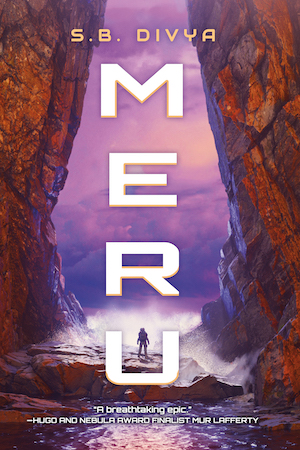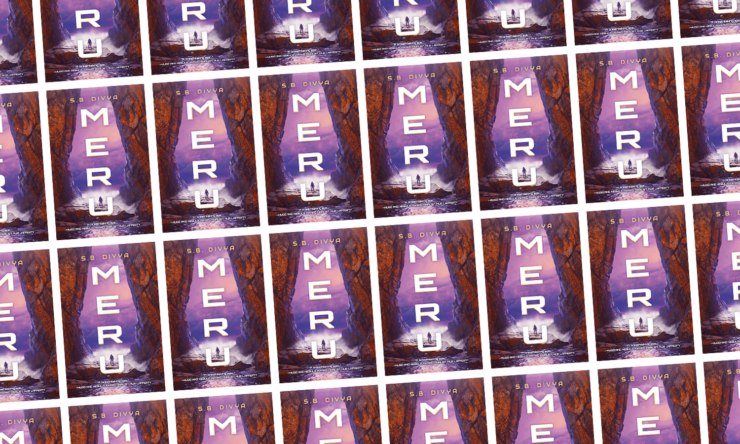One of the obvious things that science fiction lets us do is imagine what humanity’s future could look like: Will we travel to the stars? And if so, what will we do there, and how will society have changed along the way? Many authors have explored potential scenarios, and many of those imaginings come with a world where humans continue to try to conquer everything they come across. Sometimes that drive is depicted positively, sometimes negatively, sometimes a mix of both. But in all these instances, homo sapiens’ drive to grow and conquer remains the same.
But what if that didn’t have to be the way? What if humans (or the beings that evolve from us) take a different approach to their place in the cosmos? What if growth and expansion aren’t the end-all and be-all for civilization?
These latter questions are part of the premise for S.B. Divya’s Meru. The story takes place multiple centuries in our future and follows Jayanthi, a human child who was lovingly created by alloy parents. Alloys are Divya’s exploration of what could happen as humanity continues to explore genetic manipulation—they have homo sapiens in their ancestry, but in the centuries since their augmentations made them uniquely separate from humans, they have designed their DNA in various ways. Most are now able to live outside of a gravity well (and, in fact, most can no longer be planetside in their natural form), and can survive in the vacuum of space. Alloys also live for several centuries rather than a paltry one. These changes have made them largely unrecognizable from their human ancestors, and they come in all shapes and sizes. They are also paternalistic of their human ancestors, who have since been confined to Earth after making a mess of their homeworld as well as Mars. All beings in the universe (and in this future, a being is not just living things but other objects like planets as well) deserve respect and to not be harmed, something that humans ignored in the past with devastating effects.
Buy the Book


Meru
Alloys’ views of humans vary. Some want to give them a chance to explore space once again, and others think they should remain docile and confined to Earth, like unruly children unable to control their desire to indiscriminately harm the environments where they live. Our protagonist, Jayanthi, is raised in this society where having ambition is literally designated as a disorder. She also has Sickle Cell disease, an unintended consequence of her alloy parents making her from a previously phased-out gene line.
When alloys discover a planet named Meru that has conditions close to that of Earth’s, she is more than intrigued—could this be the chance for humans to once again travel to the stars? Because of her Sickle Cell disease, Jayanthi is particularly suited to Meru—the disease allows her to tolerate the atmosphere’s higher saturation of oxygen better than a human without the condition. With the help of her alloy mentor, she gets herself placed in an experiment to show how humans can live on a planet without altering it. As a mere human, she needs an alloy to take her there (pilot alloys can fit humans in a specially created organ inside them) as well as monitor her. Vaha is the alloy who ends up on the job, although zie was not at the top of the list.
Divya has said that Jayanthi and Vaha’s story is inspired by the Hindu epic, “Nala and Damayanti,” though Meru veers enough from that tale that it wouldn’t be considered a retelling. But over the course of their journey to the newly discovered planet, Jayanthi and Vaha—a human and an alloy—fall in love, something that’s taboo in this society. The two face threats to the experiment on Meru as well, and when those against humans once again traveling in outer space seek to sabotage the project, they are torn apart and have their own journeys in the cosmos before ultimately finding each other again.
The alloys alone are worth the price of the book if you’re into sci-fi that uses the fundamentals of science as we know it today to create a future that seems remarkably different from our own. (Still need to be convinced? Another ability of alloys is that they can create another organic being from their own body that their consciousness can log into and out of at will, and which allows their consciousness to travel in places their larger form could not.) We’re introduced to several different alloy individuals in Meru, and they are all intriguing in their makeup as well as in their respective ambitions.
There’s more to the book than just the alloys, of course. Jayanthi and Vaha’s romance is also sweet, though those looking for something that centers on that romance won’t find it here. Just like with Divya’s other work, Machinehood, it’s the ideas she explores that make up the most interesting parts of Meru. And in the case of this book, it’s Divya’s vision of a future that isn’t dominated by exploration and unchecked growth that make it a welcome addition to the genre. This future is not a utopia, but it is a hopeful one.
Meru is the definition of epic sci-fi, and it’s also a story that is different from what we’ve seen before in that subgenre. It’s a worthy read for fans of that space (pun intended, sorry), but perhaps especially worth a read for those who have warily eyed books in that category in the past.
Meru is published by 47North
Read an excerpt here.
Vanessa Armstrong is a writer with bylines at The LA Times, SYFY WIRE, StarTrek.com and other publications. She lives in Los Angeles with her dog Penny and her husband Jon, and she loves books more than most things. You can find more of her work on her website or follow her on Twitter @vfarmstrong.










